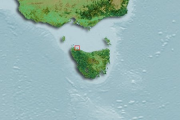Environmental Management
Type of resources
Topics
Keywords
Contact for the resource
Provided by
Years
-
A comprehensive and detailed multibeam sonar-based map of the shelf-break region of the Central Flinders Commonwealth Marine Reserve (CMR). It illustrates the extent that several canyon-head incisions are present in this region, and that inset from the shelf-break is a relatively extensive area of cross-shelf reef. Some of the canyon-head incisions are characterised by exposed reef areas, and these are indicated by localised regions of rapid change in depth. The cross-shelf reef is generally very low profile, but characterised by distinct reef ledges where bedding planes in the sedimentary rock types have eroded. These ledges, often between 1-2 m in height, can run for several kilometres as distinct features. The method of data extraction is based on Lucieer (2013). Three are three classes of seafloor map- one from GEOBIA, one from digitisation and one from Probability of Hardness based on Angular Profile Correction. Lucieer, V (2013) NERP broad-scale analysis of multibeam acoustic data from the Flinders Commonwealth Marine Reserve, Prepared for the National Environmental Research Program. Internal report. IMAS, Hobart, TAS [Contract Report]
-
Marine benthic habitat data for Tasmanian coastal waters from the LWM (Low water mark) to 40 metres in depth or 1.5 kms from shore. See 'Lineage' section of this record for full methodology and data dictionary. This data is also available via the Seamap Australia National Benthic Habitat Layer - a nationally consolidated benthic habitat map. https://metadata.imas.utas.edu.au/geonetwork/srv/eng/catalog.search#/metadata/4739e4b0-4dba-4ec5-b658-02c09f27ab9a
-
Intraspecific variation in the thermal tolerance of microscopic giant kelp (Macrocystis pyrifera) sporophytes was tested using a common garden experiment, where 49 unique family-lines were raised under four different water temperatures (12, 16, 20, and 24°C). The unique family-lines were taken from ongoing giant kelp gametophyte cultures held at IMAS, and represented F1 offspring from seven 'selfed' individuals collected from 6 sites across ~250km in Tasmania, Australia, in addition to a site-level cross from each of the sites, and a panmictic cross using the 42 pure family lines. Survivorship of the selected warm-adapted family-lines after outplanting trials at restoration sites can be found here with the associated dataset "NESP Marine Hub Project E7 outplanted kelp survivorship". https://metadata.imas.utas.edu.au/geonetwork/srv/eng/catalog.search#/metadata/908afd8c-cc7a-4ea3-a87e-4497ae8da87a
-
Water quality and biological data was collected from four tide-dominated river estuaries indicative of catchments with varying levels of human impacts to: 1) assess draft indicator levels for water quality, and 2) investigate biological indicators of estuarine health in NW Tasmania. This data includes sampling from Detention River, Duck Bay, Montagu River and Black River
-
Water quality and biological data was collected from four tide-dominated river estuaries indicative of catchments with varying levels of human impacts to: 1) assess draft indicator levels for water quality, and 2) investigate biological indicators of estuarine health in NW Tasmania. The data represented by this record was collected in the Black River.
-
Water quality and biological data was collected from four tide-dominated river estuaries indicative of catchments with varying levels of human impacts to: 1) assess draft indicator levels for water quality, and 2) investigate biological indicators of estuarine health in NW Tasmania. The data represented by this record was collected in the Duck Bay.
-
Water quality and biological data was collected from four tide-dominated river estuaries indicative of catchments with varying levels of human impacts to: 1) assess draft indicator levels for water quality, and 2) investigate biological indicators of estuarine health in NW Tasmania. The data represented by this record was collected in the Montagu River.
-

Water quality and biological data was collected from four tide-dominated river estuaries indicative of catchments with varying levels of human impacts to: 1) assess draft indicator levels for water quality, and 2) investigate biological indicators of estuarine health in NW Tasmania. The data represented by this record was collected in the Detention River.
 TemperateReefBase Geonetwork Catalogue
TemperateReefBase Geonetwork Catalogue